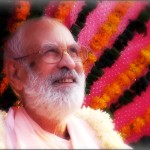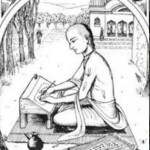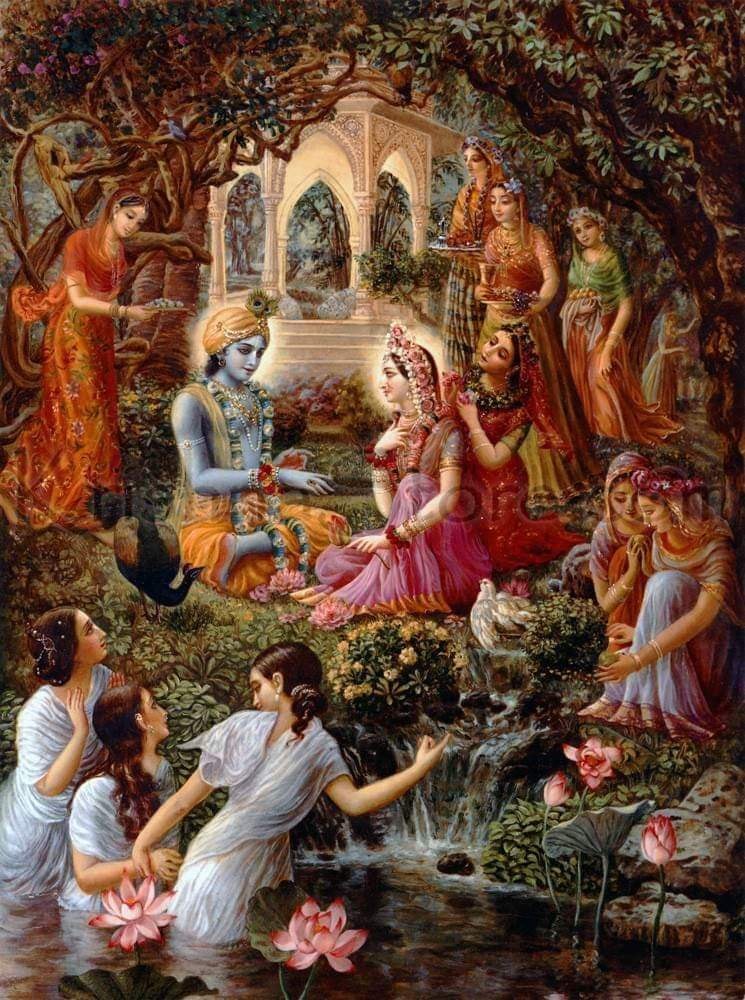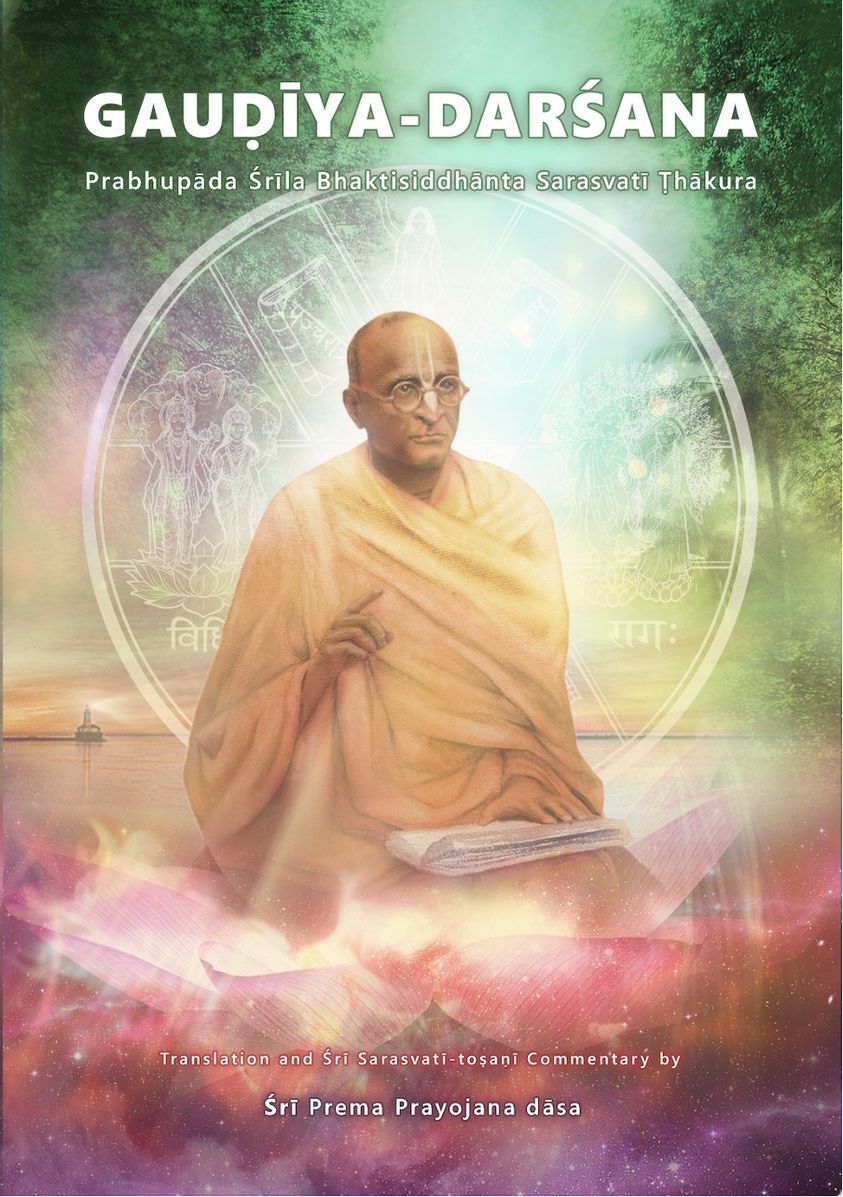Samadhi
INSPIRATIONAL QUOTATIONS
This illumination, comes from Srila Bhaktivedanta Narayana Maharajas Bhagavad Gita Chapter 6 Texts 18-25

Srila Bhaktivedanta Narayana Maharaja
SLOKA 18
When the mind becomes completely controlled and
firmly fixed in the self alone, at that time one is said
to be yukta (perfected in yoga), and is free from the
craving for all sense enjoyment.

Srila-Visvanatha Cakravarti Thakura
PURPORT BY SRILA VISVANATHA CAKRAVARTI THAKURA
When is ones yoga complete? In reply to this, Sri Krishna
speaks this sloka beginning with yada. One has become a
nishpanna-yogi (has attained perfection in yoga) when he can
situate the controlled citta (mind) unwaveringly in the atma
(self).
PURPORT BY BHAKTIVEDANTA NARAYANA MAHARAJA
during his yoga practice, his citta becomes steady, free from
desires for sense enjoyment, and situated within his self alone.
SLOKA 19
Just as a lamp in a windless place does not flicker,
so a yogi whose citta is controlled remains steady in
his concentration on self-realisation.
PURPORT BY SRILA VISVANATHA CAKRAVARTI THAKURA
A lamp does not flicker in a place where there is no breeze,
therefore the citta (mind) of a yoga-yukta-yogi is compared
to a lamp.
SLOKA 20-25
In that state of yoga called samadhi, the yogi.s mind
is controlled by the practice of yoga. He becomes detached
from the sense objects, and is satisfied within
by realising the self through that purified citta (mind).
In that state, the yogi experiences eternal bliss through
his transcendental intelligence, which is beyond the
realm of the senses. Being thus established, he never
deviates from his atma-svarupa (intrinsic nature) and
upon attaining atma-sukha (the bliss of the self), he
considers there to be no greater acquisition. When he
is situated on that platform, he does not become perturbed
even by the greatest of miseries. Know that
state to be devoid of any contact with the duality of
mundane happiness and misery. This yoga should be
performed with full patience of mind, having completely
given up all whimsical desires and, with the
mind controlling the senses from all directions, one
should follow the instructions of sastra and sadhu with
determination. One should make his intelligence resolute
and determined, and should gradually become
detached by establishing the mind in the self and by
not thinking of anything else.
PURPORT BY SRILA VISVANATHA CAKRAVARTI THAKURA
The word yoga in the sloka, naty-asnatas .tu yoga .sti
(Gita 6.16) and in other slokas means samadhi. This
samadhi is of two types, namely samprajnata, in which one
is conscious of the difference between knowledge, the object
of knowledge and the knower, and asamprajnata, in
which no such difference is perceived. Samprajnata has
various divisions such as sa-vitarka (argument) and savic
ara (philosophical research). What is spontaneous or
asamprajnata-samadhi-yoga? To answer this, Sri Bhagavan
is speaking three and a half slokas beginning here with
the word yatroparamate.
When one attains samadhi, the citta becomes fully detached
from sense objects and has no contact with them,
because one has achieved self-restraint (niruddha). This
is confirmed in Patanjali.s Yoga-sutra: yogas citta-vrittinirodha
h. .When the citta-vritti (attention) is fully restrained
from sense enjoyment and absorbed in the blissful
realisation of the self and Paramatma, it is called
yoga.
The qualified yogi realises Paramatma by his purified mind
and remains satisfied with that alone. This is his blissful
state, samadhi. This samadhi is attained by an intellect
which has become qualified to experience the self and
Paramatma. This is because it is atindriya (beyond the
senses), and beyond the happiness attained by contact of
the senses with the sense objects. Wherever this yogi lives,
he does not deviate from his atma-svarupa and thus, after
attaining this blissful state, he considers the pursuit of any
other type of acquisition as insignificant. Even if there is
contact with misery, he does not experience it. This is yogasa
mjnitam, or simply yoga, and only this can be called
samadhi. A yogi should not lament, .I have not attained
perfection after so much time, so what is the purpose in
undergoing all this pain?. Rather, within his mind, he should
maintain firm patience. .Whether perfection comes in this
life or in the next, I will continue to endeavour. Why should
I become impatient?.
In this regard, Sri Gaudapada, Sankaracarya.s paramagurudeva,
has given the example of vowing to dry up the ocean
by taking out a drop of water at a time with the tip of a piece
of kusa grass. Similarly, by untiring, determined endeavour,
a person can control the mind.
In this regard there is a story. Once a bird laid her eggs on
the shore of an ocean, but the waves carried the eggs away.
The bird resolved to dry up the ocean, and began to take water
out, drop by drop, in her beak. Other birds came to convince
her that her endeavour was futile, but she did not stop her
work. By chance, Sri Naradaji came to that place, and he
also tried to convince the bird to stop, but the bird took a
vow in his presence: .I will not rest until I dry up the ocean,
whether it is in this life or in the next.. Merciful Narada
then sent Garuda to help her. When Garuda heard that the
ocean had carried away the eggs of someone in his own caste,
he began to dry up the ocean by fanning it with his wings.
The ocean became terrified, and immediately gave the eggs
back to the bird.
Thus it is certain that when a person begins the process
of yoga, jnana or bhakti with faith in such statements of
sastra, Sri Bhagavan will definitely bless such enthusiastic
endeavour.
In the two slokas beginning with the word sankalpa, Sri
Bhagavan is explaining the initial and ultimate activities of
a person engaged in such yoga. Abandoning all material desires
(Gita 6.24) is the initial act and not worrying about
anything else, as spoken in Gita (6.25), is the final act.
PURPORT BY BHAKTIVEDANTA NARAYANA MAHARAJA
Words cannot describe the happiness that manifests in the
yogis pure heart when he attains perfection in yoga, and his
heart becomes cleansed by samadhi. It can only be realised
with one.s purified mind.
Srila Bhaktivinoda Thakura says, In this way, by the practice
of yoga, the mind gradually becomes detached from sense
enjoyment and free from the control of all mundane objects.
At that time, the stage of samadhi appears. In that state, the
mind becomes qualified to realise and experience Paramatma,
thus realising the happiness born from that union. Patanjali
Munis philosophical literature is the only bona fide literature
on ashtanga-yoga. Because commentators do not understand
its factual meaning, they say that, according to the
vedanta-vadis (propounders of Vedanta), the attainment of
bliss and the conscious state of the self is called moksha. This
is unreasonable because, if bliss is accepted in the kaivalya
(liberated) stage of impersonal monism, then the duality of
the experience and the one who has the experience will exist.
Thus it will not be kaivalya (oneness). But these commentators
do not understand what Patanjali Muni means,
because in his last sutra he has said:
purushartha-sunyanam gunanam pratiprasavah
kaivalyam svarupa-pratishtha va citi-saktir iti
Yoga-sutra 3.34
The function of the real self (cit-dharma) awakens when one is
free from the four goals of human life (dharma, artha, kama and
moksha), and when the gunas do not cause any worldly disturbance.
This state is called kaivalya (oneness). In this state one becomes
situated in ones own svarupa. It is then called citi-sakti.
If we deeply deliberate on this it becomes clear that Patan
.If we deeply deliberate on this it becomes clear that Patanjali
Muni does not accept that the functions of the self are annihilated
in its ultimate state; rather, he accepts that at that stage
no transformation or perversion of its function takes place.
Citi-sakti means cit-dharma. When there are no perverse transformations
in the proper functioning of the self, then svarupadharma,
the true nature of the self, awakens. When that state
of the self is in contact with the material energy, it is called
atma-guna-vikara (the transformation of the constitutional
functions of one.s self). If perverse transformations are removed,
then ananda, which is an intrinsic characteristic of
the atma, will awaken. This is the opinion of Patanjali.
.Ananda awakens when one is free from any perversion
by the gunas and is of a blissful nature. It is the supreme end
of yoga. Later, it will be explained that this and nothing else
is called bhakti.
Samadhi is of two types: samprajnata and asamprajnata.
Samprajnata-samadhi has many divisions such as sa-vitarka (argument)
and sa-vicarana (philosophical research). But
asamprajnata-samadhi is only of one type. In the state of
asamprajnata-samadhi, one attains eternal bliss, which is devoid
of any contact of the senses with their sense objects through the
intelligence which has become qualified to experience the true
self or has become one with the self. In that pure state of realising
eternal bliss within the self, the mind of the yogi does not deviate
from the Absolute Reality. Without attaining this state, the jiva
can never achieve eternal auspiciousness merely by the practice
of ashtanga-yoga. This is because, if the yogi is deprived of this
blissful state, then the secondary results of this practice in the
form of mystic powers and so on attract his mind, and will deviate
him from the topmost objective which is samadhi-sukha (bliss
in trance). Due to such obstacles, there is the danger of many
inauspicious mishaps in the practice of this ashtanga-yoga such as
degradation and deviation. In bhakti-yoga, however, there is no
such danger. This will be explained later on.
The yogi does not consider any other bliss to be superior
to the bliss achieved in samadhi. In other words, while maintaining
his life, he experiences temporary happiness through
contact of the senses with their sense objects, but he considers
this to be completely insignificant. Even at the time of
death, while tolerating the extreme pain of an accident or
bodily miseries, he enjoys the bliss of samadhi, which is the
only object of his search. Being unmoved by all these pains,
he still does not give up his supremely blissful state. He understands
that these miseries will not stay for long and will
disappear soon enough. If there is a delay or any obstacle in
achieving the result of yoga, he does not become so frustrated
that he gives up his practice. With great endeavour he continues
his yoga practice until he attains the result.
The first duty on the path of yoga is to follow yama,
niyama, asana, pranayama and so on and to completely abandon
desires which are born from the attraction to attaining
mystic siddhis. In addition, with the help of the purified mind,
the yogi should control his senses. He should gradually learn
renunciation with intelligence acquired from following the
limb of dharana (concentrating the mind). This renunciation
is called pratyahara (withdrawal of the senses from the
sense objects). He should achieve atma-samadhi by completely
controlling his mind through the processes of dhyana, dharana
and pratyahara. In the final state, he should not think any
mundane thoughts, and should not become attached to the
maintenance of his body while thinking about it. This is the
ultimate duty of the yogi..










